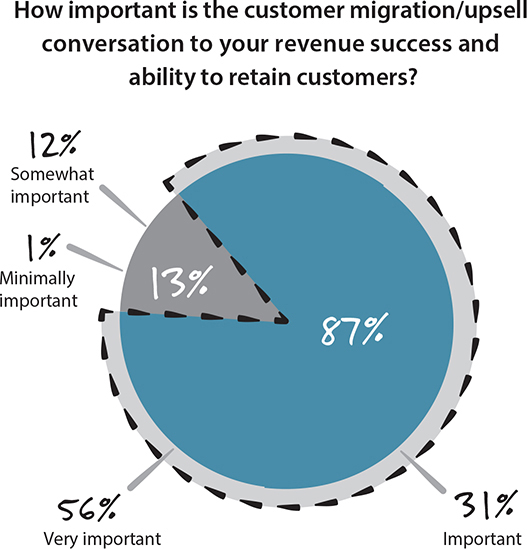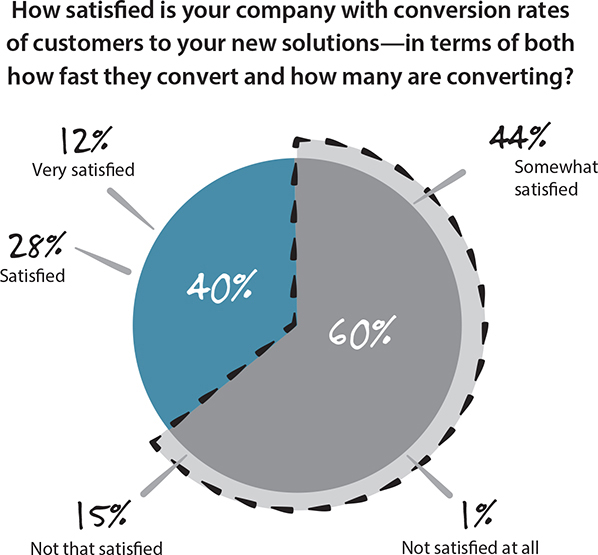 6
6 
Messaging for the Upsell
The Why Evolve Conversation
The chapters you’ve read thus far have validated one key idea: Your customer conversations cannot be “one size fits all.” Different buying scenarios have different psychologies and thus require different messages.
But there’s still a gap. And it’s a big one. Because if you’re like most organizations, you don’t want to keep selling the same thing to the same customers over and over, even if you are able to get them to pay more for it. Eventually, you’re going to want to sell them new stuff. Better stuff. Higher-value stuff.
That’s the “Why Evolve” moment. And by their own admission, companies are mishandling it in a big way.
WHAT’S AT STAKE IN A WHY EVOLVE CONVERSATION?
The vast majority of respondents to a Corporate Visions survey believe upselling clients to higher-value solutions is an absolutely critical part of their growth strategy: 87 percent of respondents told us the upsell is “important” or “very important” to their revenue and retention goals (Figure 6.1). Despite this, however, a smaller majority, nearly 60 percent, admit they’re only “somewhat satisfied” or worse when it comes to the speed and rate at which they convert existing customers to new solutions (Figure 6.2).

Figure 6.1 The majority agree: Upsell and add-on sales are important to companies’ revenue and retention strategies . . .

Figure 6.2 . . . but they’re less than satisfied with their ability to convert existing customers to new solutions.
Convincing customers to migrate to a new solution should, theoretically, be easier than selling to brand-new prospects. Existing customers know you. You have a history together. They’re more likely to pay attention to your marketing communications and meet with you to hear about your new offering.
But this conversation can go sideways on you without warning, surfacing hidden challenges and complexities that could scuttle any chance to forge that higher-value relationship, or even set the relationship back.
If you succeed at the Why Evolve conversation, you lay the groundwork for better customer experiences and longer-lasting relationships. If you stumble, these relationships stagnate. Just ask yourself how likely you are to achieve your annual goals if you only retain customers without growing your business with them.
And plateauing revenues aren’t your only problem. If you aren’t supporting your customers with continual, remarkable experiences and relevant solutions, they’re all the more vulnerable to your competitors’ disruptive messages. It’s not about simply stalling out. It’s about losing them entirely.
So before diving into the framework, it’s worth taking a closer look at what can go wrong in this critical conversation.
A successful upsell message needs to answer each of the following five questions:
1. Is it different enough? Your customers live in a noisy world, which makes it hard for you to break through and be seen as different enough to compel action. And as you know from reading about Status Quo Bias, if everything looks similar, the safest course of action is to stay the same. So how do you create a message that’s not what the customers expect—that’s unusual enough to pique their interest?
2. Is it important to their success? To become the incumbent, you had to create a buying vision—that is, a vision of their future in which you and your solutions are pivotal to their success. Any new solution you propose needs to fit into that initial vision; otherwise, you risk disrupting yourself and undermining your Incumbent Advantage.
3. Is it personally convincing? Any message you create must not only show the value your new solution brings to their business but convince them to become personally invested in championing your cause.
4. Does it incite change? One of your advantages as the incumbent is that your customers see any change as a risk. So how do you get your customers to take the risk and prioritize the change without sacrificing that advantage?
5. Does it drive purchase intent? Ultimately, everything comes down to the purchase. Will they or won’t they buy your solution? Even a small advantage can make a big difference. So how do you craft a message that gives you that critical edge?
Taken together, these questions present a conundrum: To address them all, you really need to answer two questions: “Why Change?” (the ideal customer acquisition framework) and “Why Stay?” (the winning retention framework). But you’ve heard throughout this book that introducing a change message to an existing customer is dangerous. You’ve also heard that the only way to change a customer’s status quo is to disrupt it. That means you have to walk a delicate line between reinforcing the status quo and introducing just enough disruption to incite change. That’s a tough proposition for even the most seasoned marketers and sellers.
This conversation is critical enough to your growth that it shouldn’t be haphazard, based on guesswork, or built around some scientifically unproven formula. It deserves a message based on the buyer psychology in the moment at hand.
In short, it needs its own message framework.